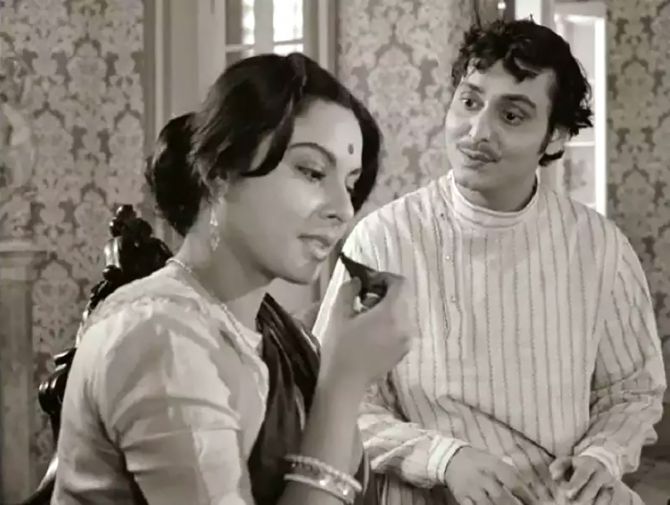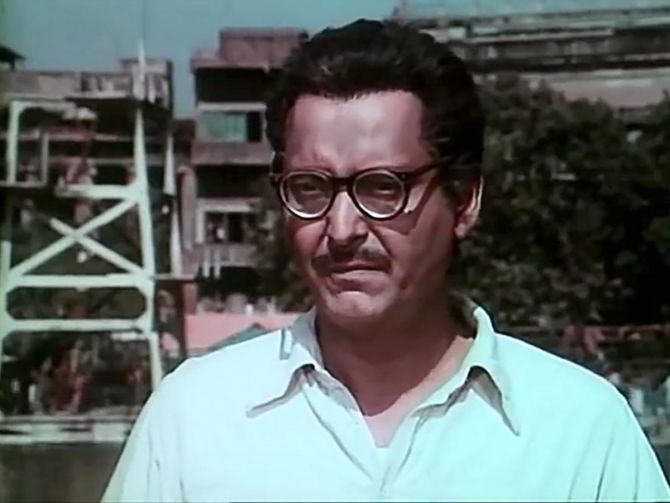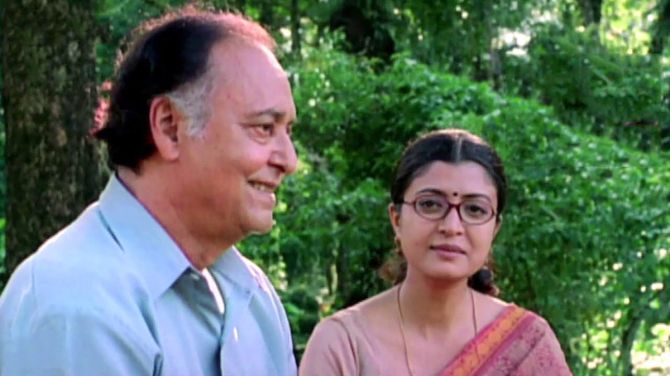 | « Back to article | Print this article |

He was the actor who epitomised the best of world cinema, transcending the boundaries of country, state and language to give expression to Satyajit Ray's cinematic vision and get framed in celluloid greatness.
But the legacy of Soumitra Chatterjee, who died on November 15 at the age of 85, is not limited to the Ray firmament, just as he was never only a Bengali star of Bengali cinema.
The suave actor of the world, sometimes called the last of the Mohicans and familiar to students of cinema anywhere in the globe, acted in 14 Ray films and over 300 others, gracefully transitioning into commercial cinema in a variety of roles. He made his presence felt on the stage too -- as actor, playwright and director.
One of the acting world's greatest luminaries slipped away just a day after the festival of lights -- and more than a month after he was admitted to a Kolkata hospital with COVID-19.
The actor is dead, his work lives on.
As debuts go, his was one for the history books, the image of a bearded young man with his son on his shoulders in that still from Apur Sansar imprinting itself in filmic greatness.
His portrayal of a grieving widower who ultimately reconnects with his estranged son in the 1959 film that completed Ray's famous Apu trilogy made him the toast of world cinema community.
And the rest as they say is history.
According to film lore, Chatterjee auditioned for Ray's Aparajito in 1957, the second movie in the trilogy that began with Pather Panchali, but the director found the actor, then 20, too old to play the adolescent Apu.
Chatterjee, however, remained in touch with Ray and eventually landed the role of Apu. His bearded look, it is said, reminded Ray of a young Tagore.
In the decades that followed, Chatterjee became the go-to actor to play characters of certain age and intelligence in movies and theatre while also writing poetry and plays.
It was a lifelong pursuit of the arts that has finally ended.

Born in Calcutta (now Kolkata) in 1935, Chatterjee, spent his early years in Krishnanagar in Nadia district where he completed his schooling.
He was introduced to acting through family stage plays by his grandfather and lawyer father, both amateur theatre actors. Chatterjee did his master's in Bengali literature from Calcutta University.
Interested in the arts from a young age, he saw a play by Bengali theatre doyen Sisir Bhaduri.
It was a turning point, making him realise he wanted to be an actor.
However, it was only when he reached the sets of Apur Sansar on August 9, 1958, for his first day of shooting that he knew he had found his calling.
There was no looking back after that and Chatterjee became an integral part of Bengal's art and cultural life with his movies.
But he represented India too on the world stage.
A black and white photograph of a dapper Chatterjee in a white Nehru jacket and black trousers -- with Shashi Kapoor, Madhur Jaffrey and Felicity Kendall between them -- at the Berlinale in 1965 where his film Charulata won Ray the best director award resurfaced recently and was widely shared on social media with men and women old and young sighing at the elegance and charm of the days that once were.
But copybook handsome Chatterjee may not have agreed.
In a 2008 interview with CNBC, he described himself as the ugly duckling of his family.
This lack of confidence, he said, helped him focus more intently on his craft.
And my substantial work in theatre has established that I am not just a Satyajit Ray puppet, he added famously.

After all, Chatterjee was often referred to as Ray's alter ego, their cinematic relationship giving expression to one of the greatest eras in the history of world cinema.
The maestro's favourite actor played the lead in masterpieces such as Devi (1960), a taxi driver in Abhijan (1962), Arayner Din Ratri (1970), Ghare Baire (1984) and Sakha Prashakha (1990).
The three-decade camaraderie ended only with the film maestro's death in 1992.
Their collaboration has often been compared to celebrated actor-director pairings such as Mifune Toshiro-Akira Kurosawa, Marcello Mastroianni-Federico Fellini and Max von Sydow-Ingmar Bergman.
'... He influenced me enormously. He was one of my mentors I would say. I would not be here had he not been there,' Chatterjee told PTI in 2012.
He also worked with other greats -- Mrinal Sen, Tapan Sinha and Tarun Majumdar.
His role as the swashbuckling villain Mayurbhan in Sinha's Jhinder Bondi saw him team up with the legendary Uttam Kumar.
They worked together in eight films and were known for their different approaches to cinema -- Kumar, the romantic hero of the masses, and Chatterjee the intellectual, maybe more cerebral star.

Chatterjee was also considered one of the first proponents of the naturalistic style of acting in Bengali cinema -- a trademark of Ray's movies.
His role as Kshitda, a swimming coach in the movie Kony, with the dialogue 'Fight, Kony, fight!' is still remembered as an example of indomitable spirit and inspiration against all odds.
Known to be a perfectionist, Chatterjee in his later years worked with Goutam Ghose, Aparna Sen and Rituparno Ghosh.
The consummate actor, a pancreatic cancer survivor, kept going even in his 80s -- in the National Award film Mayurakshi (2017), Bela Sheshe (2015) and Posto (2017).
Standouts in his theatre career include his rendition of Shakespeare's King Lear in Suman Mukhopadhyay's play that earned him accolades both nationally and globally.
He also wrote over 15 plays and directed more than 30 stage productions.
Despite several offers, Chatterjee never ventured into Bollywood as he felt he wouldn't get the freedom to pursue his other literary genres.
A yoga enthusiast, he edited the magazine Eksan (Now) for more than two decades.
But Chatterjee was not just about cinema and theatre.
Unlike many celebrities, the die-hard Marxist was vocal about his views and spoke out on controversial issues such as societal intolerance and the 2016 demonetisation exercise.

And he never hungered for awards, in fact often demonstrated his aversion for them.
He turned down the Padma Shri twice.
In 2001, he also refused the National Award to protest the alleged 'biased attitude' of the awards committee which gave his film Dekha a Special Jury honour while giving the main award to Hindi film Pukar.
However, he later received the Padma Bhushan in 2004.
In 2006, he won the National Award for Poddokhep.
He became the first Indian actor to receive the Officier des Arts et Metiers, the highest award for arts given by the French government in 1999. He also received a Lifetime Achievement Award from Italy.
In 2012, he won the Dadasaheb Phalke Award and in 2018 Légion d' honneur, the highest civilian award in France.
French film-maker Catherine Berge had directed a full-length documentary named Gaach on Chatterjee's life and work.
Chatterjee is survived by his wife Deepa Chatterjee, daughter Poulomi Basu and son Sougata Chatterjee.
